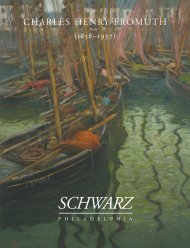pdf - Schwarz Gallery
pdf - Schwarz Gallery
pdf - Schwarz Gallery
Create successful ePaper yourself
Turn your PDF publications into a flip-book with our unique Google optimized e-Paper software.
The Creation of a Peaceable Kingdom<br />
Of the Peaceable Kingdom paintings by Hicks, the pictures that comprise the border Kingdom series are clearly those in<br />
which Hicks was teaching himself how to paint easel works. As a sign painter he would have learned how to combine visual<br />
elements and utilize the techniques of tracing and transfer of image material to compose an integrated image that would<br />
convey a single idea. Using these familiar techniques Hicks composed his Kingdom tableaux using images from selected print<br />
sources and sketches taken from life. Examination of a number of these early border Kingdom works using x-radiography and<br />
infrared reflectography illustrated just how much Hicks relied on these techniques to assemble his imagery. Extensive<br />
underdrawing can be seen of not only the animals and figures but also landscape and foreground elements. A number of these<br />
formative paintings, when radiographed, indicate that Hicks painted the surrounding landscapes intuitively. A complete sky,<br />
then the mountainous landscape, and the middle ground and foreground imagery would have been meticulously executed,<br />
layer upon layer, to create the overall landscape perspective. Additional underdrawing, appearing as detailed and completed<br />
sketches, becomes visible beneath selected animals. In many cases these animals have been directly associated with<br />
contemporary print sources and, as one might expect, often appear in reverse orientation from the print source image, an<br />
artifact of the tracing and transfer processes he used. With this in mind, one can often see these “lifted” images as animals<br />
that seem to float, curiously, amidst the more practiced aspects of his composition.<br />
It is interesting to note that Hicks, a devoted and charismatic Quaker minister, often referred to his love of easel painting<br />
as an indulgent character flaw. That he was capable of a more academic style of painting and rarely pursued it until the end<br />
of his life might largely be attributed to the constraints of the Quaker religion to which he was quite devoted, a religion that<br />
largely eschewed decorative painting and ornamentation for favor of plainness and simplicity of dress. It is not an<br />
uncommon assertion that the inclusion of a Biblical text or proverb as a text border was yet another way of avoiding similar<br />
criticism while also combining his love of painting with his ministry.<br />
As Hicks gained confidence with his subject, his unique style emerged. The text borders disappeared and in time gave way<br />
to larger image areas. The effort to execute realistic, atmospheric perspective seems to relax, giving way to a flatter picture<br />
plane. The landscape begins to tilt toward the viewer and the animals and figures appear as if cut from paper, arranged one<br />
atop another throughout the landscape. It is here that we become aware of a certain resurgence of his training and<br />
background as a sign painter where softer, sculptural three-dimensional modeling gives way to bold, calligraphic brushwork<br />
and a certain “posterization” of form. Another example of the return to sign painting technique can be seen in the use of<br />
drop shadowing. These broad-stroke, characteristic shadows that surround and give emphasis to lettering come to use in the<br />
outline and shadowing of animals and figures.<br />
This painting stands as an extraordinary example in Hicks’s evolution of the Peaceable Kingdom from both an aesthetic and<br />
academic point of view. It is actually an example of a late border Kingdom. The text border has been removed and the work<br />
installed on a new support in its present dimension, apparently during the artist’s lifetime. That the text border remains<br />
extant, reading: “A little child was leading them in love,/And not one savage beast was seen to frown,/His grim carniv’rous<br />
nature there did cease,/When the great PENN his famous treaty made,” resonates as metaphor for the pivotal place this work<br />
occupies in the genre. The image has been achieved with a meticulously executed cloud-filled sky, largely obscured by foliage<br />
and landscape as in the early Kingdom works. Now, though, the picture plane begins to tilt toward the viewer. Strong though<br />
somewhat tentative drop shadows begin to appear, defining figures, and the animals themselves appear flatter and more<br />
graphic, in composition. The atmosphere of the sky is treated less academically, with billowing clouds giving way to the<br />
characteristic blue-to-pink sky that is often associated with the later Kingdom pictures, now appearing on the horizon. His



